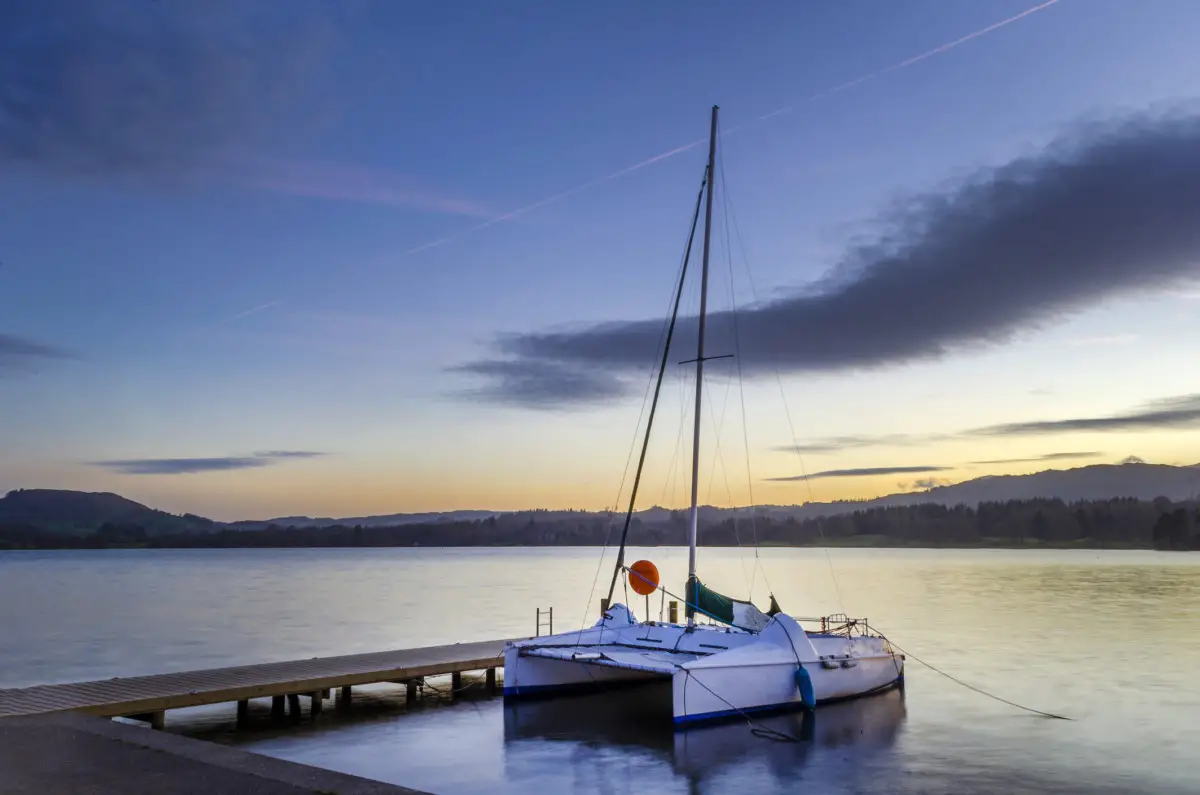As an Amazon Associate, we earn from qualifying purchases. We may also earn commissions if you purchase products from other retailers after clicking on a link from our site.
Large-sized catamarans are appealing due to their ample spacing and comfort. Therefore, a cruising family or couple looking to buy a boat is more likely to go for one of these. But are there small cruising catamarans that provide the performance, comfort, and amenities found in larger boats?
The best catamarans under 30 feet (9.14 m) include the TomCat 6.2, Cadillac 27and 30, Gemini 30, Endeavour 30, and Maine Cat. These time-tested cruising cats are easy to handle, premium built, and are great for daytime sailing, overnight trips, and some even suitable for long-range sea passages.
In this article, you’ll find a list of the best cruising catamarans below 30 feet (9.14 m). Keep reading to discover which catamarans make this list, what they have to offer, their pros and cons, and how much they cost.
If you are unsure whether or not 30ft is too small for your needs, then I suggest you check out another article I wrote named Best Size Catamaran, it will discuss why length matters and how it affects safety.
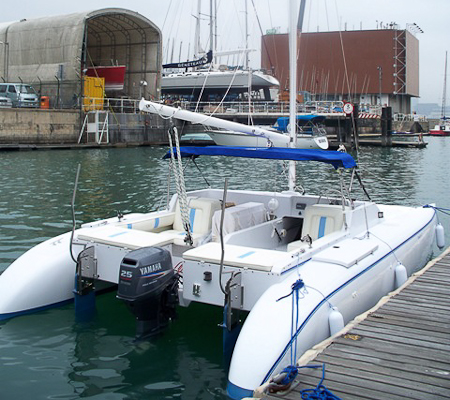
TomCat 6.2
Unlike most catamarans designed for racing purposes, the TomCat 6.2 is a medium-sized cat that’s well-suited to daytime cruising. It boasts high-quality construction, vacuum-bagged hulls, and a plywood-reinforced deck.
This 20 footer (6.09 m) comes with an 11-foot (3.35 m) beam and not only offers you safety and comfort but performance and versatility as well.
This boat has a centrally placed outboard engine and two rudders that allow it to turn quickly and maneuver confidently into and out of marina slips. The 9.9 hp outboard propels it to speeds of around 8 knots (9.21 mph or 14.8 kph), though the boat has the potential to move faster if desired.
This simpler type of cat (just one engine as an example) also allows for cheaper and easier maintenance. Maintenance costs are something most people underestimate when getting a cat, if you want to get some real numbers from actual sailors then I suggest you read this article (How much does it cost to maintain a cat).
The boat sails with minimal heeling, comfortably accommodate 6-8 people, and you can sail it single-handed or take a crew.
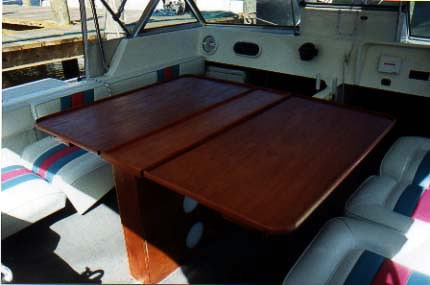
High and narrow hulls bearing arched bottoms allow for a low wetted surface. The hull design provides low resistance and a great deal of reserved buoyancy and also enables you to drive through closely spaced waves.
On most 20-footers (6.1 m), driving through waves generates a smooth but wet ride, but with the TomCat’s enclosed deck (link to parts names explained here), you are safe and protected behind a windshield and the high bulwark.
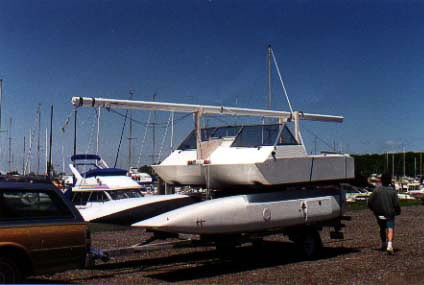
The TomCat makes an excellent cruiser because it performs impressively well both under sail and power. It combines the performance of a modern sailing cat with the comfort, style, and convenience of a powerboat. It’s also trailerable since you can detach the hulls from the deck, winch up the deck on a trailer, and slide the hulls underneath.
But the best part is that it’s easy on the pocket, with the price ranging between $36,750 and $44,580.
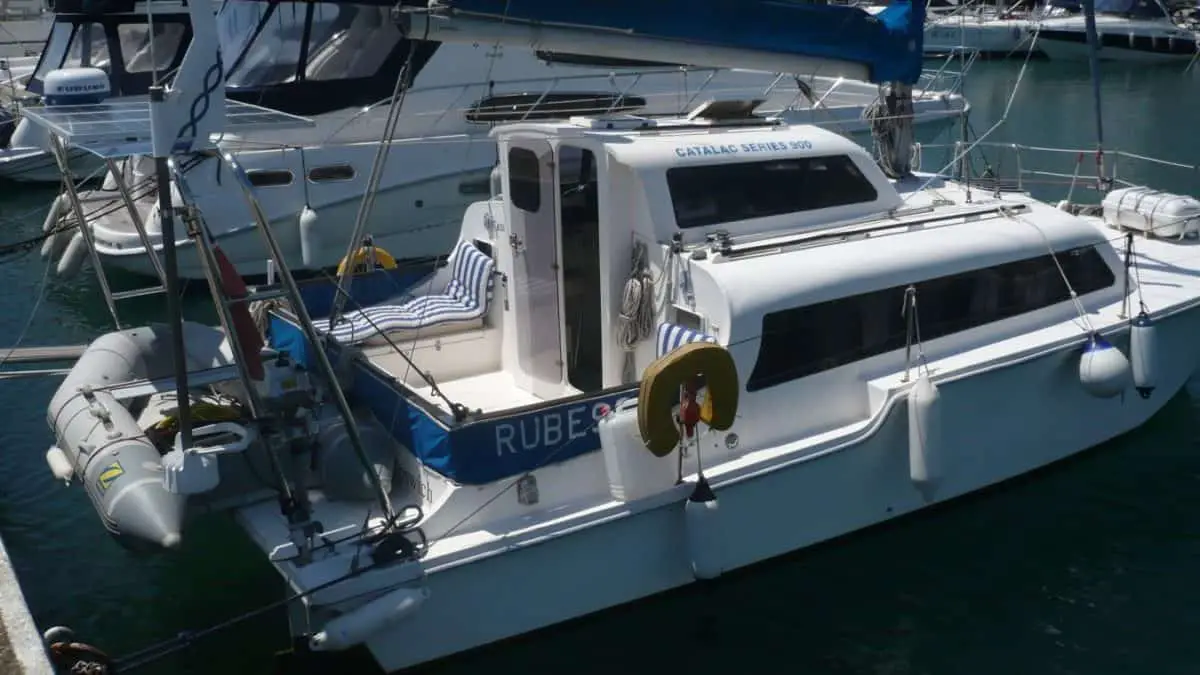
Catalac 30 (9M)
The Catalac brand consists of strongly built vessels that sport thick hulls, glass windows, narrow beams, and vertical transoms. Catalac 30 was the first vessel in this popular British cruising line designed by Tom Lack in the late 60s. The boat’s appeal was attributed to its safety, ample spacing, well-built interior, and load-carrying abilities.
These characteristics are extremely important on a safe catamaran, overloading your cat makes it sit lower in the water, increases drag, reduces handling and speed, there is stuff you should know about this (so that you can make an educated buy). I have created an article where I try to explain the basics of a safe cat (link here)
Sporting 5 berths, a massive galley, plus a cockpit with a sheltered steering position, the 30-foot (9.1 m) Catalac makes an excellent floating home for a cruising family. It sails exceptionally well, doesn’t heel (heeling explained here), and delivers a reasonable motor-sailer level of performance.
Furthermore, the hulls provide adequate headroom, allowing those on board to move around comfortably, and there’s enough space on the deck for sunbathing.
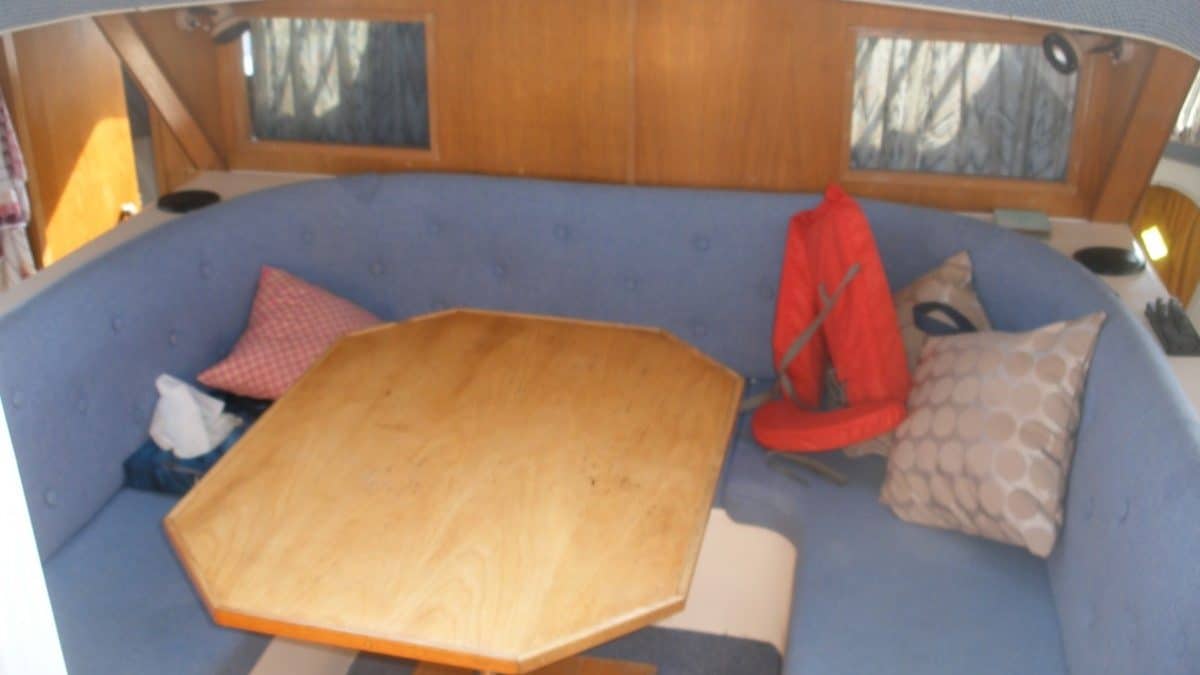
The Catalac’s structure features solid fiberglass, chined hulls, and a staggered sheerline that allows easy aft access. With a modest rig that’s easy to handle, the Catalac can deliver top speeds of up to 12-14 knots (13.81-16.11 mph / 22.22-25.9 kph) under sail.
Given that the boat’s design focuses more on comfort than speed, this is a spectacular performance.
Catalac 9M requires a skilled hand when turning into the wind as it is prone to blowing sideways. This is because the boat lacks ballast (which helps in keeping momentum during a tack) but also centerboards (explained here).
Skills are always the most essential things to bring aboard and you can acquire them in many ways, my two favorite ways are through NauticEd courses (two free courses here) or by reading books (my top 15 books here)
Back to the boat! This model came in two versions; the standard layout contained a 30-40hp outboard, while the second option had duo engines. The latter is easier to maneuver into a marina.
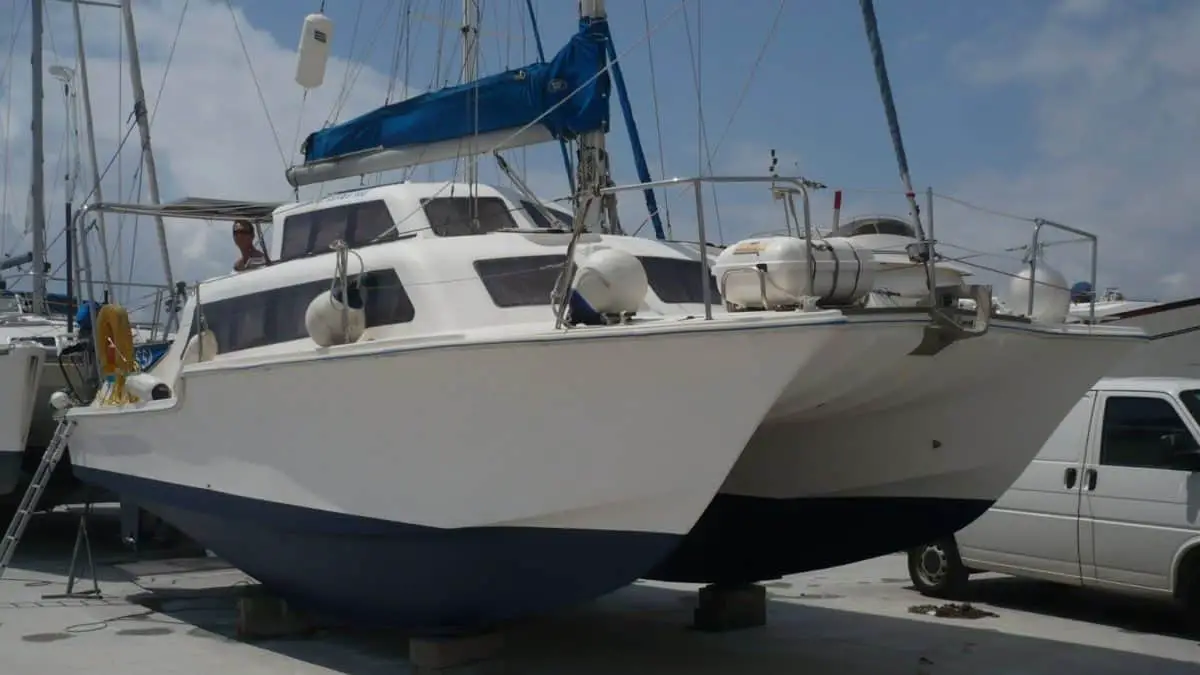
These cats retain their value pretty well. However, they might not be easy to come by since most owners find it challenging to get their hands on a larger boat with similar qualities and performance.
A Catalac 30 (9M) goes for between $33,000 and $55,000.
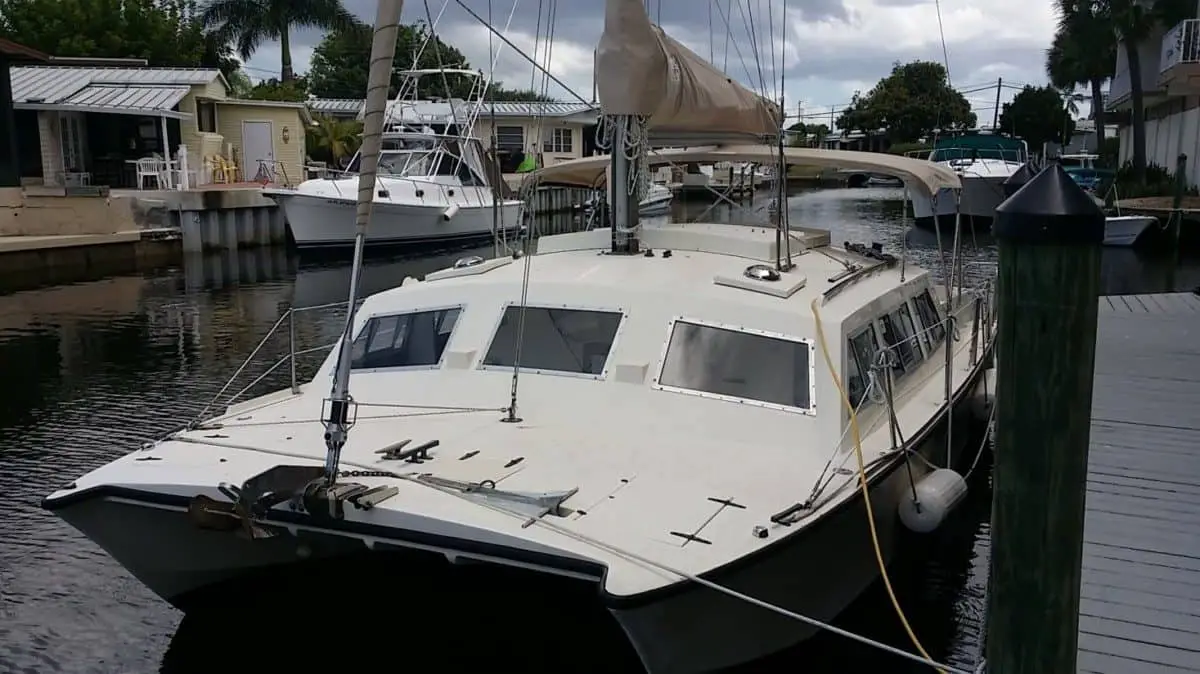
Catalac 27 (8M)
The Catalac 27 8M is a pocket cruiser that boasts a strong reputation for high quality, durability, and strength. Besides, the boat’s design makes it somewhat suitable for bluewater sailing (understand why the small size is an offshore problem).
Built like a battleship, the boat contains solid fiberglass hulls. Additionally, it comes with double engines, a large cockpit fitted with cushions all around, and features standing headroom in each hull.
As discussed above, double engines are great for maneuvering a marina, and having spare propulsion if one breaks down, but make sure you are able to carry the extra cost (cost of maintenance on a cat Link here)
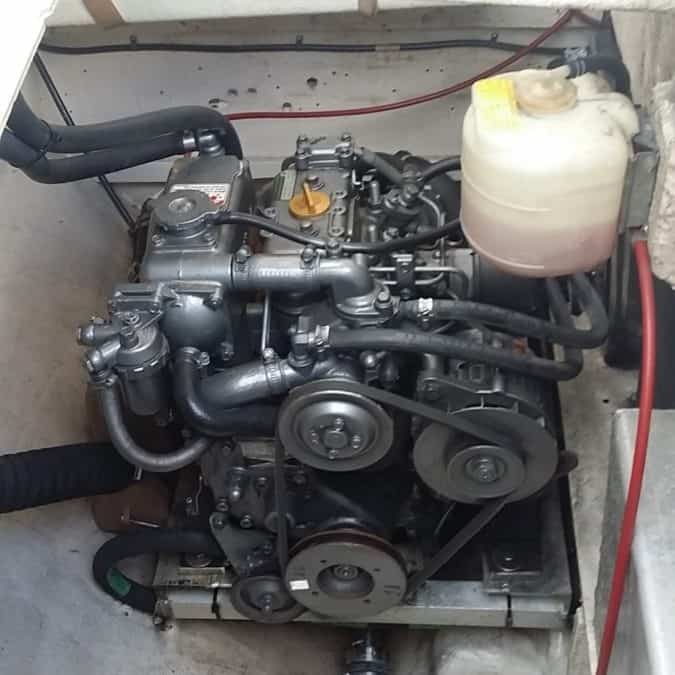
Like the Catalac 9M, this boat comes with two different layouts; a twin inboard diesel engine or an outboard engine. The twin-engine models can motor up to 1000 km (621 miles, read more on cat fuel consumption here) without needing to refuel, while the 70 amps of charge plus water tanks (70 gallons / 265 liters) make these vessels remarkable coastal cruisers.
Catalacs equipped with outboard engines sail faster since you can raise the engine during sailing and are also lighter. This helps to minimize drag. Catalac 8M sports a short but thick mast that helps make the boat stable.
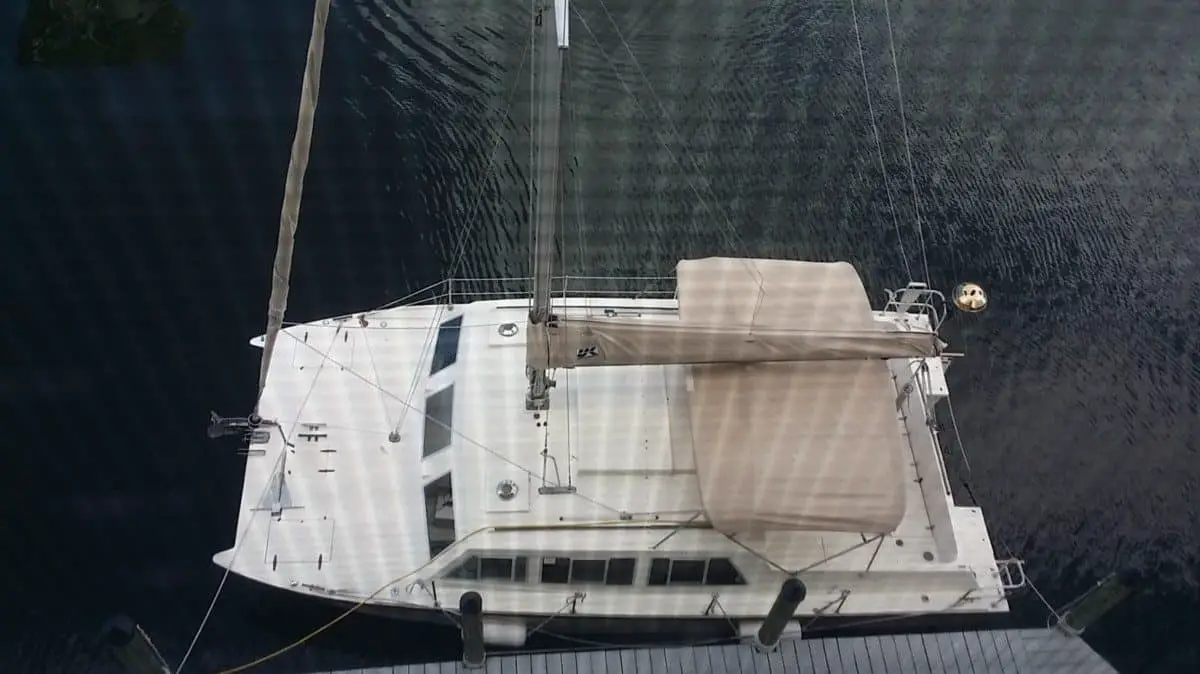
Though small in size, this catamaran packs a lot of features in its small frame. It has a full-sized berth, a large galley that’s almost 8 feet (2.4 m) long, a quarter berth, head, and navigation station.
What’s more, the cockpit is as large as that of a 38 to 40-foot (11.5 to 12.1 m) cat.
Catalac 27 costs about $31,836.
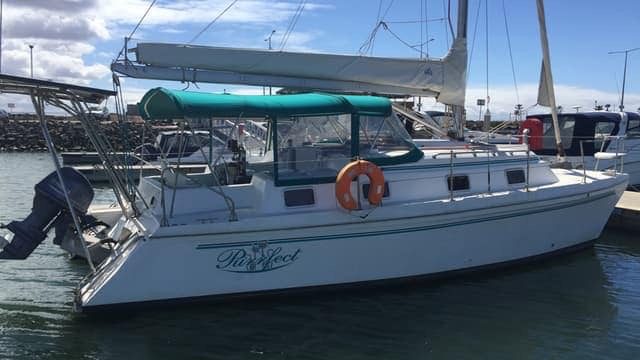
The Endeavour 30
The Endeavour 30 catamaran is a boat characterized by stability, ample deck space, and a spacious interior. It boasts fast cruising speeds under both sail and power.
The boat has mini keels and rudders plus symmetrical hulls separated by a hydra-cell. The latter is a center section with a characteristic V-shape.
Mini keels are easy to maintain and some even break off without damaging the boat (if you were to hit an underwater object). But center or daggerboards are a much more efficient way of reducing sideways slippage (link to Center VS Daggerboards explained here).
The boat’s vacuum-bagged construction helps enhance strength and stiffness while reducing weight. Furthermore, the interior has a fiberglass mold, providing extra strength and rigidity. With sufficient breeze, this vessel can deliver reasonable off-the-wind and doable upwind speeds.
As such, you can expect to attain speeds of about ~10 knots (11.51 mph or 18.5 kph) on power reaches. Below is a video showing a panoramic tour of the Endeavour 30:
This vessel has the internal capacity of a 40-foot (12.1 m) monohull. And you can tell this from the unique layout merging the cabin and cockpit with wide doors to the numerous features packed into this 30-foot (9.14 m) vessel.
It has a spacious salon, an enormous galley, two queen berth staterooms with plenty of storage space, a head with separate showers, and a sizable U-shaped dinette.
You can get this boat for under $50,000.
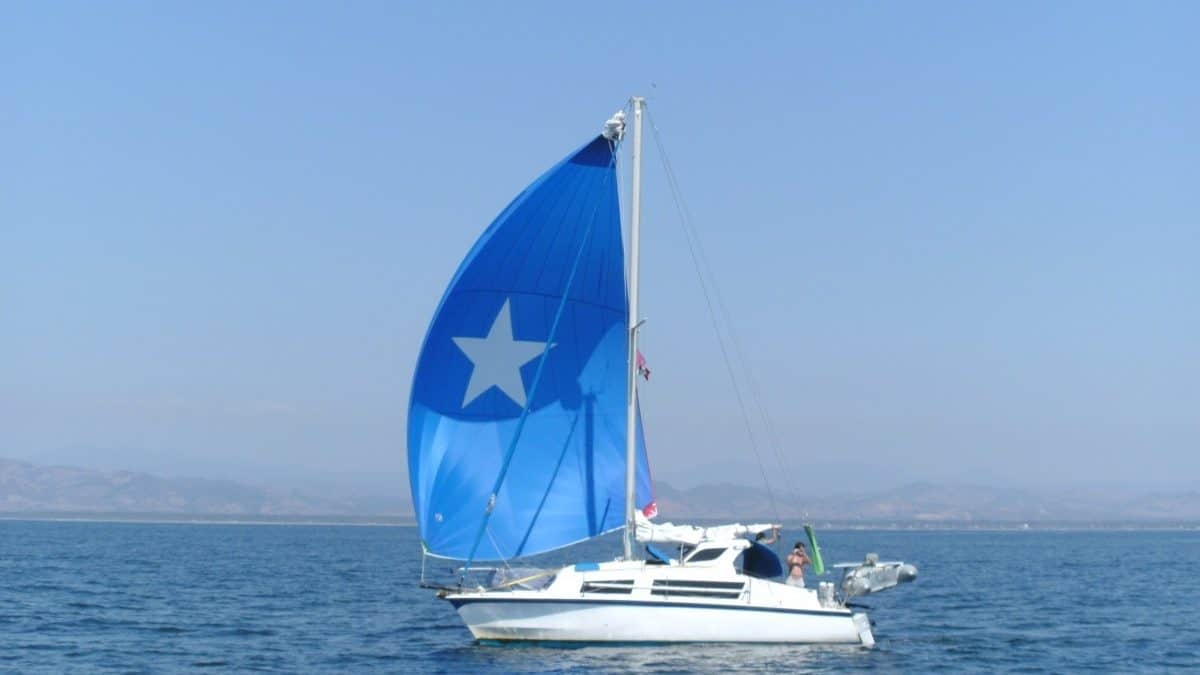
Gemini 30
The Geminis by Tony Smith were the United States’s first production cruising cats. Today, these vessels remain the most appealing American-built cruising catamarans. Built between 1981 and 1990, the Gemini 30 does not have a contemporary design, but it works remarkably well for cruisers desiring generous living space in a small affordable sailboat.
At only 14 feet (4.2 m) across, Gemini cats are somewhat narrow. But this means they can easily fit into most of the regular marina berths.
Besides, the boats still contain enough interior space for a queen-size double berth and two smaller doubles housed in separate guest rooms.
There’s also a modest but serviceable saloon with duo settees and a collapsible table that can transform into an additional double berth.
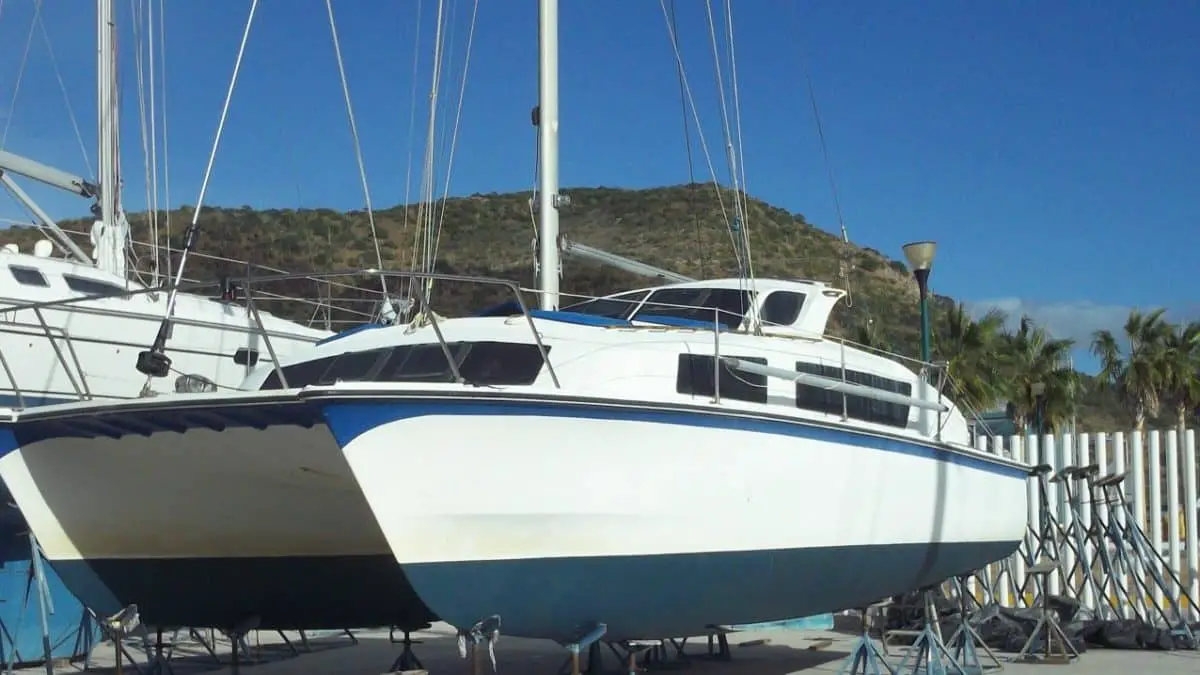
For the Gemini 30, this translates to a cruising cat with standing headroom that can comfortably accommodate 3 couples in private cabins or a family with small children. A good-sized galley, a spacious head with a shower, nav desk, and a large comfy cockpit make up the Gemini 30’s cruising palace.
Catamaran layout is highly personal and if you want to learn more about different characteristics then I suggest you read my article Designing the perfect catamaran layout (Link)
While not that fast, the Gemini 30 will easily outsail the Endeavor 30 discussed above. Its daggerboards (which are explained in detail here) can point well, and if you keep it light, it can do 7-8 knots (12.9-14.8 km/hr) under sail.
Besides, raising the daggerboards reduces the wetted surface area, and increases the speed downwind.
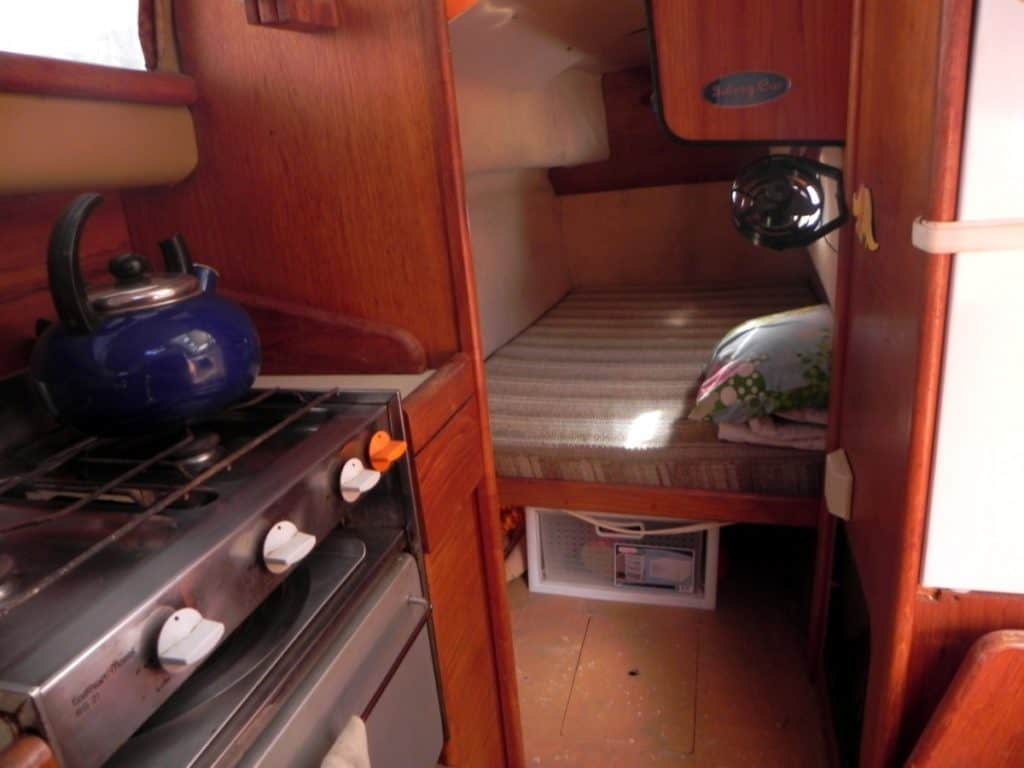
The Gemini 30 tends to pound and hobbyhorse a little when sailing in choppy waters – particularly when overloaded (more on load carrying capabilities in this article), but the deep pivoting daggerboards provide stability and lift underwater.
Furthermore, the Gemini’s retractable rudders enable it to venture into shallow waters.
This is a very popular cruising cat that’ll give you a lot of bang for your bucks.
You can find a Gemini for less than $65,000.

Maine Cat 30
The Maine Cat 30 combines premium quality construction materials with the most advanced building techniques to create a lightweight vessel capable of handling most offshore conditions. What’s more, this boat can remain trouble-free for years on end with little effort.
If you are in the market for a simple liveaboard cruiser that you can use for a short weekend getaway or a cruising voyage, this is it.
The boat has a sizable primary stateroom berth with ample overhead space and a dresser fitted with a hanging storage cabinet. The enormous head includes a toilet, sink, 20-gallon (75.71 L) holding tank, vanity, and a pressurized shower.
Covering the open bridgedeck is a permanent hardtop. This spacious bridgedeck can hold quite a crowd and comes with a convertible dinette that turns into an extra berth. If need be, you can even enclose the entire space using acrylic windows or screens.
Gabo

The 360-degree visibility from the cockpit allows the captain plus the crew a panoramic view, and all sail controls go back to the cockpit, which is very useful if wanting to sail single-handedly.
I believe that most boats should be set up in this way since sooner or later you might be in a situation where there is only one person to handle the controls, such as in an emergency. But more on that in another article (Link).
The Maine Cat 30 is a classic boat that delivers on high-performance multihull sailing. Designed to offer much better performance than catamarans bearing tall and heavy bridge decks, this cat weighs less and suffers less windage thanks to the acrylic windows.
The boat’s interior layout allows for easy cleaning as surfaces sport a smooth gel coat and satin-finished cherry trim. The solid but lightweight furniture bears the same Core-Cell foam core employed on the hull, deck, and hardtop. Plus, there’s ample storage for all your sailing equipment, cleaning supplies, and provisions.
A Maine Cat 30 can cost up to $110,000.
Heavenly Twins 27
The overall design of this well-equipped catamaran makes it a superb pocket cruiser.
Heavenly Twins 27 manages to fit not one but two coachroofs on hulls that are only 27 feet (8.20 m) long. Canoe sterns and a central cockpit separating the duo coachroofs form the boat’s other prominent features.
Famous for their excellent build quality, medium-depth draft, and narrow beams, Heavenly Twins 27 appeals to a wide range of boating enthusiasts.
These include solo sailors, weekend sailors, cruising families, circumnavigators, beginner sailors, and experienced liveaboards such as this famous Youtube channel “Kittiwake”.
The vessels house double cabins in the hulls while the forward starboard contains the heads and, to port, the galley. You can easily access the bar from the well-protected cockpit while the Comfordesk accommodation converts into a double dock.
A stoop through allows access from below-deck to the aft compartment without going through the cockpit. There’s ample storage space throughout the boat, plus you can section off the large stateroom into smaller double compartments if desired.
The price range for this boat is $ 20,098 to $24,193. (I believe that kittiwake is for sale too)
Aquilon 26
The last cruising catamaran on my list is the Aquilon 26. This French-built cruising vessel is light in weight and trailerable, which means you can disassemble it in a few hours or transport it as-is.
Designing a boat that is possible to disassemble usually means that it is structurally less strong, which by no means is a problem during coastal sailing but the Aquilon 26 is mostly attractive to sailors who prefer inland lake sailing. It’s also suitable for beginner sailors.
Although there are no real “beginner cats” there are specs to consider if you are a beginner with catamarans, most of them I have listed in another article (here).
Gabo
This 26-footer (7.92 m) has the potential for good speed though its layout is anything but conventional- which forms part of its appeal.
The cockpit works as the saloon, and a full bimini protects the crew from lousy weather. The starboard hull contains a dinette and galley, and the port has a double berth stateroom. The windows are quite unusual, but they provide lots of light, remarkably enhancing interior visibility.
Aquilon 26 can deliver an average cruising speed of 10knots (11.51 mph or 18.5 kph).
On a beam reach, you can expect around 25 knots (28.77 mph or 46.3 kph) with an adequate breeze ( I have never sailed at 25knots but researching this boat supposedly it is possible).
You can get this boat for under $50,000.
What Makes Small Cruising Cats Attractive?
Small cruising cats are ideal for sailing along the coast. But that’s not all. Under capable hands, properly fitted smaller cats can also deliver spectacular offshore passages similar to their larger counterpart (Heres a list of full-sized bluewater cats).
They can operate over long cruise ranges, cross oceans, and circumnavigate the globe. Smaller cats are also suitable for day sailing, overnight trips, and coastal or inland voyages.
For most sailors, comfort on board is crucial, so they’ll look for a vessel that guarantees a comfortable cruising experience. The good thing is that smaller vessels provide almost the same qualities and amenities that bigger vessels offer. Plus, you can do quite a bit with the available space, especially if it’s well laid out.
You’ll find that most 30-footer (9.14 m) or more miniature cruising cats comprise a galley, head, bunks, navigation and entertainment electronics, and refrigeration.
Sailors usually talk about these benefits of smaller cats:
- They’re less expensive. Large boats are costly to buy. They also cost more to hire, maintain, and dock. You can buy a small-sized boat at a much lower price, and parts tend to cost less too. Besides, you get to use smaller sails, winches, and lighter lines than those applicable on a larger boat. And since marine services such as moorings and haul-outs get billed via boat length, a smaller cat makes sailing more affordable.
- They boast superior builds. Most cruising boats under 30 feet (9.14 m) feature designs that are 30+ years old. In those days, weather forecasts were hard to come by and not as accurate, so boat builders used hulls with thicker fiberglass than the type found in today’s builds. Furthermore, everything in the boat, including rigs, rudders, hulls, keels and decks, was designed to withstand strong winds and high waves.
- They have simpler systems. This means less time spent fixing and maintaining your boat. For instance, most small cruising cats often lack water-makers, hot water systems, or electric anchor windlasses.
- They’re easier to handle. Smaller cats are simpler to sail than larger cats. It’s also easier to sail one single-handed or with a small crew.
What is the largest cat on person can sail?
The Disadvantages of Smaller Cruising Cats
Below are some of the most discussed downsides of small cats:
- They have limited living space, storage, and amenities.
- Though they don’t heel much, they are less comfortable than larger boats since they get tossed around much more easily in big ocean swells.
- It’s not easy to accommodate crew for extended periods; hence there are fewer hands to share work.
- They are slower and take longer to get to their destination.
Conclusion
Though fewer are on the cruising trails than their larger counterparts, small catamarans make ideal cruisers because they are simple, seaworthy, and pocket-friendly.
When choosing the best cat for your needs, focus on quality rather than size. A well-planned 30-footer (9.14 m) is reliable and provides ample space for your accommodation, dining, and relaxation, plus a storage room for provisions and any spare parts you might need.
And if you want even more info than I have presented to you in this article I would recommend a book from Serj, he makes it easy to understand why size matters and how to find a cat suited for your needs (amazon link)

